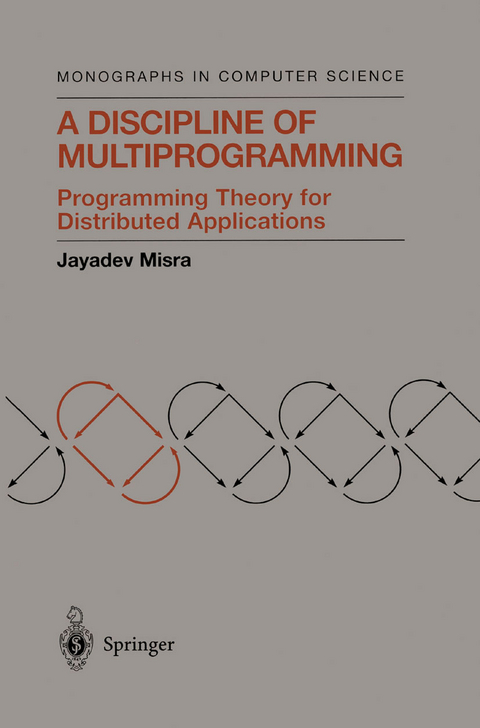
A Discipline of Multiprogramming
Springer-Verlag New York Inc.
978-1-4612-6427-9 (ISBN)
A Discipline of Multiprogramming.- 1.1 Wide-Area Computing.- 1.2 An Example: Planning a Meeting.- 1.3 Issues in Multiprogram Design.- 1.4 Concluding Remarks.- 1.5 Bibliographic Notes.- 2 Action Systems.- 2.1 An Informal View of Action Systems.- 2.2 Syntax and Semantics of Action Systems.- 2.3 Properties of Action Systems.- 2.4 Examples.- 2.5 Concluding Remarks.- 2.6 Bibliographic Notes.- 3 An Object-Oriented View of Action Systems.- 3.1 Introduction.- 3.2 Seuss Syntax.- 3.3 Seuss Semantics (Operational).- 3.4 Discussion.- 3.5 Concluding Remarks.- 3.6 Bibliographic Notes.- 4 Small Examples.- 4.1 Channels.- 4.2 A Simple Database.- 4.3 Management of Multilevel Memory: Lazy Caching.- 4.4 Real-Time Controller; Discrete-Event Simulation.- 4.5 Example of a Process Network.- 4.6 Broadcast.- 4.7 Barrier Synchronization.- 4.8 Readers and Writers.- 4.9 Semaphore.- 4.10 Multiple Resource Allocation.- 4.11 Concluding Remarks.- 4.12 Bibliographic Notes.- 5 Safety Properties.- 5.1 Introduction.- 5.2 The Meaning of co.- 5.3 Special Cases of co.- 5.4 Derived Rules.- 5.5 Applications.- 5.6 Theoretical Results.- 5.7 Concluding Remarks.- 5.8 Bibliographic Notes.- 5.9 Exercises.- 5.10 Solutions to Exercises.- 6 Progress Properties.- 6.1 Introduction.- 6.2 Fairness.- 6.3 Transient Predicate.- 6.4 ensures, leads-to.- 6.5 Applications.- 6.6 Theoretical Issues.- 6.7 Concluding Remarks.- 6.8 Bibliographic Notes.- 6.9 Exercises.- 6.10 Solutions to Exercises.- 7 Maximality Properties.- 7.1 Introduction.- 7.2 Notion of Maximality.- 7.3 Proving Maximality.- 7.4 Random Assignment.- 7.5 Fair Unordered Channel.- 7.6 Faulty Channel.- 7.7 Concluding Remarks.- 7.8 Bibliographic Notes.- 8 Program Composition.- 8.1 Introduction.- 8.2 Composition by Union.- 8.3 Examples of Program Union.- 8.4 Substitution Axiom under Union.- 8.5 Theoretical Issues.- 8.6 Concluding Remarks.- 8.7 Bibliographic Notes.- 8.8 Exercises.- 8.9 Solutions to Exercises.- 9 Conditional and Closure Properties.- 9.1 Introduction.- 9.2 Conditional Properties.- 9.3 Closure Properties.- 9.4 Combining Closure and Conditional Properties.- 9.5 Concluding Remarks.- 9.6 Bibliographic Notes.- 10 Reduction Theorem.- 10.1 Introduction.- 10.2 A Model of Seuss Programs.- 10.3 Compatibility.- 10.4 Loose Execution.- 10.5 Reduction Theorem and Its Proof.- 10.6 A Variation of the Reduction Theorem.- 10.7 Concluding Remarks.- 10.8 Bibliographic Notes.- 11 Distributed Implementation.- 11.1 Introduction.- 11.2 Outline of the Implementation Strategy.- 11.3 Design of the Scheduler.- 11.4 Proof of Maximality of the Scheduler.- 11.5 Refining the Scheduling Strategy.- 11.6 Designs of the Processors.- 11.7 Optimizations.- 11.8 Concluding Remarks.- 11.9 Bibliographic Notes.- 12 A Logic for Seuss.- 12.1 Introduction.- 12.2 Specifications of Simple Procedures.- 12.3 Specifications of General Procedures.- 12.4 Persistence and Relative Stability.- 12.5 Strong Semaphore.- 12.6 Starvation Freedom in a Resource Allocation Algorithm.- 12.7 Concluding Remarks.- 12.8 Bibliographic Notes.- In Retrospect.- A Elementary Logic and Algebra.- A.1 Propositional Calculus.- A.2 Predicate Calculus.- A.2.1 Quantification.- A.2.2 Textual substitution.- A.2.3 Universal and Existential quantification.- A.3 Proof Format.- A.4 Hoare Logic and Weakest Pre-conditions.- A.4.1 Hoare logic.- A.4.2 Weakest pre-conditions.- A.5 Elementary Relational Calculus.- References.
| Reihe/Serie | Monographs in Computer Science |
|---|---|
| Zusatzinfo | XVIII, 420 p. |
| Verlagsort | New York, NY |
| Sprache | englisch |
| Maße | 155 x 235 mm |
| Themenwelt | Mathematik / Informatik ► Informatik ► Betriebssysteme / Server |
| Mathematik / Informatik ► Informatik ► Netzwerke | |
| Mathematik / Informatik ► Informatik ► Software Entwicklung | |
| ISBN-10 | 1-4612-6427-8 / 1461264278 |
| ISBN-13 | 978-1-4612-6427-9 / 9781461264279 |
| Zustand | Neuware |
| Haben Sie eine Frage zum Produkt? |
aus dem Bereich


